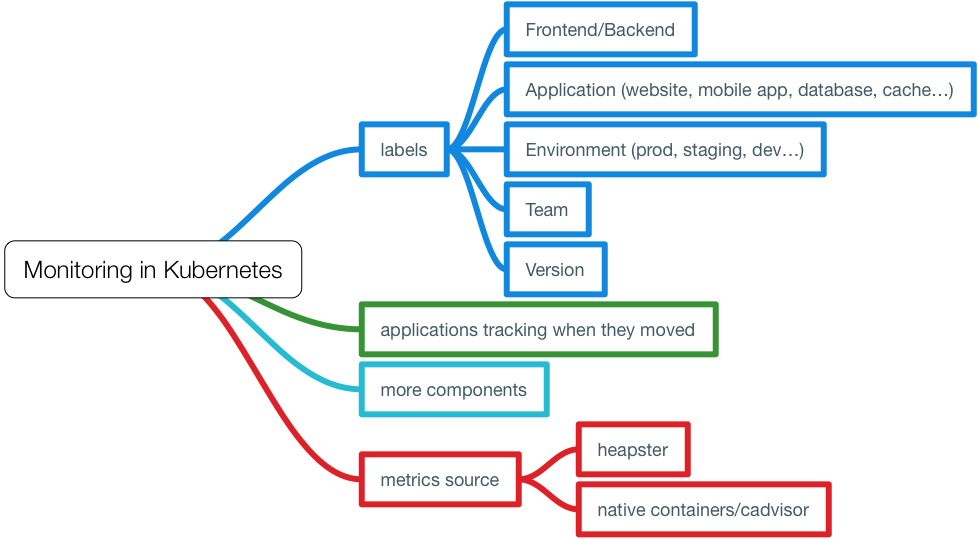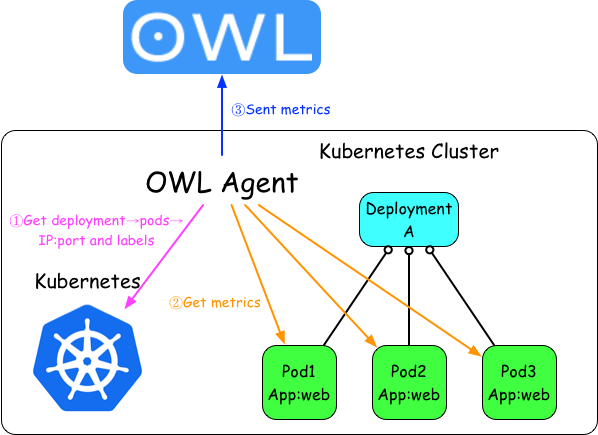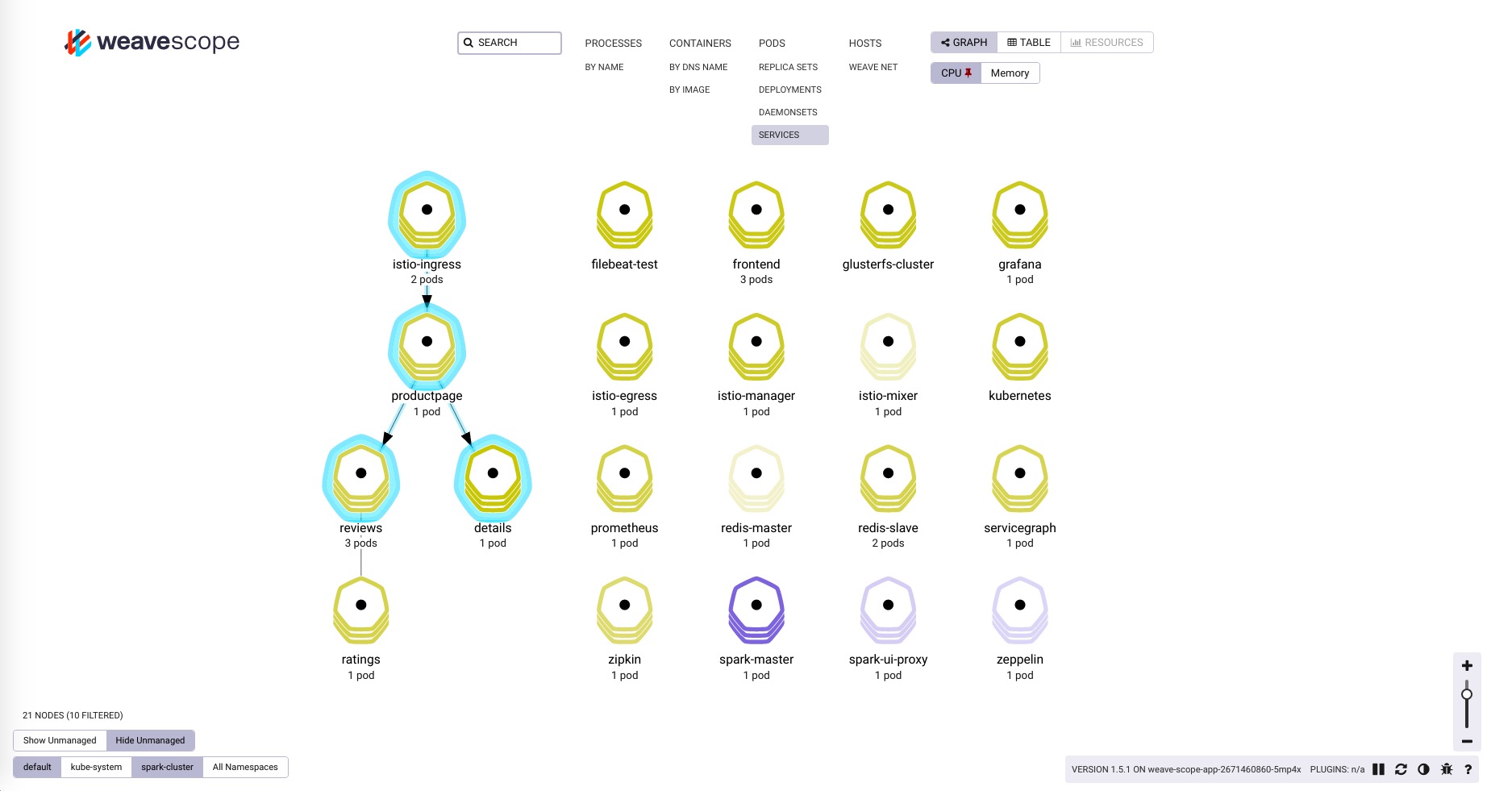9.7 KiB
集群及应用监控
在前面的安装heapster插件章节,我们已经谈到Kubernetes本身提供了监控插件作为集群和容器监控的选择,但是在实际使用中,因为种种原因,再考虑到跟我们自身的监控系统集成,我们准备重新造轮子。
针对kubernetes集群和应用的监控,相较于传统的虚拟机和物理机的监控有很多不同,因此对于传统监控需要有很多改造的地方,需要关注以下三个方面:
- Kubernetes集群本身的监控,主要是kubernetes的各个组件
- kubernetes集群中Pod的监控,Pod的CPU、内存、网络、磁盘等监控
- 集群内部应用的监控,针对应用本身的监控
Kubernetes集群中的监控
跟物理机器和虚拟机的监控不同,在kuberntes集群中的监控复杂度更高一些,因为多了一个虚拟化层,当然这个跟直接监控docker容器又不一样,kubernetes在docker之上又抽象了一层service的概念。
在kubernetes中的监控需要考虑到这几个方面:
- 应该给Pod打上哪些label,这些label将成为监控的metrics。
- 当应用的Pod漂移了之后怎么办?因为要考虑到Pod的生命周期比虚拟机和物理机短的多,如何持续监控应用的状态?
- 更多的监控项,kubernetes本身、容器、应用等。
- 监控指标的来源,是通过heapster收集后汇聚还是直接从每台主机的docker上取?
容器的命名规则
首先我们需要清楚使用cAdvisor收集的数据的格式和字段信息。
当我们通过cAdvisor获取到了容器的信息后,例如访问${NODE_IP}:4194/api/v1.3/docker获取的json结果中的某个容器包含如下字段:
"labels": {
"annotation.io.kubernetes.container.hash": "f47f0602",
"annotation.io.kubernetes.container.ports": "[{\"containerPort\":80,\"protocol\":\"TCP\"}]",
"annotation.io.kubernetes.container.restartCount": "0",
"annotation.io.kubernetes.container.terminationMessagePath": "/dev/termination-log",
"annotation.io.kubernetes.container.terminationMessagePolicy": "File",
"annotation.io.kubernetes.pod.terminationGracePeriod": "30",
"io.kubernetes.container.logpath": "/var/log/pods/d8a2e995-3617-11e7-a4b0-ecf4bbe5d414/php-redis_0.log",
"io.kubernetes.container.name": "php-redis",
"io.kubernetes.docker.type": "container",
"io.kubernetes.pod.name": "frontend-2337258262-771lz",
"io.kubernetes.pod.namespace": "default",
"io.kubernetes.pod.uid": "d8a2e995-3617-11e7-a4b0-ecf4bbe5d414",
"io.kubernetes.sandbox.id": "843a0f018c0cef2a5451434713ea3f409f0debc2101d2264227e814ca0745677"
},
这些信息其实都是kubernetes创建容器时给docker container打的Labels,使用docker inspect $conainer_name命令同样可以看到上述信息。
你是否想过这些label跟容器的名字有什么关系?当你在node节点上执行docker ps看到的容器名字又对应哪个应用的Pod呢?
在kubernetes代码中pkg/kubelet/dockertools/docker.go中的BuildDockerName方法定义了容器的名称规范。
这段容器名称定义代码如下:
// Creates a name which can be reversed to identify both full pod name and container name.
// This function returns stable name, unique name and a unique id.
// Although rand.Uint32() is not really unique, but it's enough for us because error will
// only occur when instances of the same container in the same pod have the same UID. The
// chance is really slim.
func BuildDockerName(dockerName KubeletContainerName, container *v1.Container) (string, string, string) {
containerName := dockerName.ContainerName + "." + strconv.FormatUint(kubecontainer.HashContainerLegacy(container), 16)
stableName := fmt.Sprintf("%s_%s_%s_%s",
containerNamePrefix,
containerName,
dockerName.PodFullName,
dockerName.PodUID)
UID := fmt.Sprintf("%08x", rand.Uint32())
return stableName, fmt.Sprintf("%s_%s", stableName, UID), UID
}
// Unpacks a container name, returning the pod full name and container name we would have used to
// construct the docker name. If we are unable to parse the name, an error is returned.
func ParseDockerName(name string) (dockerName *KubeletContainerName, hash uint64, err error) {
// For some reason docker appears to be appending '/' to names.
// If it's there, strip it.
name = strings.TrimPrefix(name, "/")
parts := strings.Split(name, "_")
if len(parts) == 0 || parts[0] != containerNamePrefix {
err = fmt.Errorf("failed to parse Docker container name %q into parts", name)
return nil, 0, err
}
if len(parts) < 6 {
// We have at least 5 fields. We may have more in the future.
// Anything with less fields than this is not something we can
// manage.
glog.Warningf("found a container with the %q prefix, but too few fields (%d): %q", containerNamePrefix, len(parts), name)
err = fmt.Errorf("Docker container name %q has less parts than expected %v", name, parts)
return nil, 0, err
}
nameParts := strings.Split(parts[1], ".")
containerName := nameParts[0]
if len(nameParts) > 1 {
hash, err = strconv.ParseUint(nameParts[1], 16, 32)
if err != nil {
glog.Warningf("invalid container hash %q in container %q", nameParts[1], name)
}
}
podFullName := parts[2] + "_" + parts[3]
podUID := types.UID(parts[4])
return &KubeletContainerName{podFullName, podUID, containerName}, hash, nil
}
我们可以看到容器名称中包含如下几个字段,中间用下划线隔开,至少有6个字段,未来可能添加更多字段。
下面的是四个基本字段。
containerNamePrefix_containerName_PodFullName_PodUID
所有kubernetes启动的容器的containerNamePrefix都是k8s。
Kubernetes启动的docker容器的容器名称规范,下面以官方示例guestbook为例,Deployment 名为 frontend中启动的名为php-redis的docker容器的副本书为3。
Deployment frontend的配置如下:
apiVersion: extensions/v1beta1
kind: Deployment
metadata:
name: frontend
spec:
template:
metadata:
labels:
app: guestbook
tier: frontend
spec:
containers:
- name: php-redis
image: bj-xg-oam-docker-hub-001.tendcloud.com/library/gb-frontend:v4
resources:
requests:
cpu: 100m
memory: 100Mi
env:
- name: GET_HOSTS_FROM
value: dns
ports:
- containerPort: 80
我们选取三个实例中的一个运行php-redis的docker容器。
k8s_php-redis_frontend-2337258262-154p7_default_d8a2e2dd-3617-11e7-a4b0-ecf4bbe5d414_0
- containerNamePrefix:k8s
- containerName:php-redis
- podFullName:frontend-2337258262-154p7
- computeHash:154p7
- deploymentName:frontend
- replicaSetName:frontend-2337258262
- namespace:default
- podUID:d8a2e2dd-3617-11e7-a4b0-ecf4bbe5d414
kubernetes容器命名规则解析,见下图所示。
使用Heapster进行集群监控
Heapster是kubernetes官方提供的监控方案,我们在前面的章节中已经讲解了如何部署和使用heapster,见安装Heapster插件。
但是Grafana显示的指标只根据Namespace和Pod两层来分类,实在有些单薄,我们希望通过应用的label增加service这一层分类。架构图如下:
在不改变原有架构的基础上,通过应用的label来区分不同应用的pod。
应用监控
Kubernetes中应用的监控架构如图:
这种方式有以下几个要点:
- 访问kubernetes API获取应用Pod的IP和端口
- Pod labels作为监控metric的tag
- 直接访问应用的Pod的IP和端口获取应用监控数据
- metrics发送到OWL中存储和展示
应用拓扑状态图
对于复杂的应用编排和依赖关系,我们希望能够有清晰的图标一览应用状态和拓扑关系,因此我们用到了Weaveworks开源的scope。
安装scope
我们在kubernetes集群上使用standalone方式安装,详情参考Installing Weave Scope。
使用scope.yaml文件安装scope,该服务安装在kube-system namespace下。
$ kubectl apply -f scope.yaml
创建一个新的Ingress:kube-system.yaml,配置如下:
apiVersion: extensions/v1beta1
kind: Ingress
metadata:
name: traefik-ingress
namespace: kube-system
spec:
rules:
- host: scope.weave.io
http:
paths:
- path: /
backend:
serviceName: weave-scope-app
servicePort: 80
执行kubectl apply -f kube-system.yaml后在你的主机上的/etc/hosts文件中添加一条记录:
172.20.0.119 scope.weave.io
在浏览器中访问scope.weave.io就可以访问到scope了,详见边缘节点配置。
如上图所示,scope可以监控kubernetes集群中的一系列资源的状态、资源使用情况、应用拓扑、scale、还可以直接通过浏览器进入容器内部调试等。




